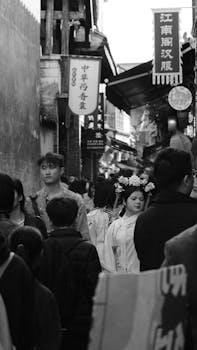
Here’s the text for the “The Street by Ann Petry⁚ An Overview” section, incorporating insights from the provided online information⁚

The Street by Ann Petry⁚ An Overview
Ann Petry’s The Street, published in 1946, quickly became a bestseller. It follows Lutie Johnson’s struggles in 1940s Harlem, highlighting the challenges faced by a Black, working-class, single mother.
Ann Petry (1908-1997) stands as a significant, though sometimes overlooked, American writer of the 20th century. Born in Connecticut, she initially trained as a pharmacist before moving to Harlem in 1938. Her experiences there, witnessing poverty and racism, profoundly impacted her work, especially her debut novel, The Street. The novel’s success, selling over a million copies, marked her as a groundbreaking voice.
Petry also authored books for younger readers, including Harriet Tubman⁚ Conductor on the Underground Railroad. Her work often explored themes of race, class, and gender, offering fresh perspectives on Black, working-class life.
Here’s the text for the “Context and Background” section, incorporating insights from the provided online information⁚

Context and Background
Understanding The Street requires knowledge of its setting. The novel is set in 1940s Harlem, a time and place marked by poverty, racism, and the struggles of African Americans.
Here’s the text for the “Harlem in the 1940s⁚ Setting the Scene” subheading, incorporating insights from the provided online information⁚
Harlem in the 1940s⁚ Setting the Scene
Harlem in the 1940s serves as a crucial backdrop for Ann Petry’s The Street. This era witnessed pervasive poverty and racism, profoundly impacting the lives of African Americans. The novel vividly portrays the crumbling tenements and harsh realities of life in this New York City neighborhood.
Lutie Johnson’s struggles are directly linked to the social and economic conditions of Harlem at this time. Understanding the historical context enhances the reader’s appreciation for the challenges she faces. The pervasive discrimination limited opportunities and perpetuated a cycle of hardship for many residents.
Petry’s novel offers a powerful glimpse into the daily lives and struggles of those living in Harlem during this period.
Here’s the text for the “Plot and Themes” heading, incorporating insights from the provided online information⁚

Plot and Themes
The Street follows Lutie Johnson’s determined pursuit of the American Dream in 1940s Harlem. The novel explores themes of race, class, and gender, highlighting the obstacles she encounters.
Lutie Johnson’s Struggle for the American Dream
Lutie Johnson’s journey in Ann Petry’s The Street embodies the arduous pursuit of the American Dream amidst the harsh realities of 1940s Harlem. As a newly single mother, Lutie is determined to create a better life for herself and her young son, Bub. She believes that through hard work and unwavering resolve, she can overcome the obstacles that stand in her way. However, Lutie’s aspirations are constantly met with frustration and disappointment as she navigates a world marked by poverty, racism, and sexism. The novel poignantly portrays Lutie’s relentless efforts to break free from the cyclical violence and despair that permeate her environment, showcasing her resilience and determination in the face of seemingly insurmountable odds. Her struggle highlights the systemic barriers that prevent many African Americans from achieving the promised prosperity and equality of the American Dream.
Themes of Race, Class, and Gender
The Street intricately explores the intersecting themes of race, class, and gender, revealing their profound impact on Lutie Johnson’s life and opportunities. Set in 1940s Harlem, the novel exposes the pervasive racism that limits Lutie’s access to education, employment, and housing. Her experiences highlight the systemic inequalities faced by African Americans in a society that marginalizes and oppresses them. Class divisions further complicate Lutie’s struggle, as she grapples with poverty and the challenges of upward mobility. As a woman, Lutie confronts sexism and gender-based discrimination, which compound her difficulties in achieving financial independence and personal fulfillment. Petry masterfully weaves these themes together to create a powerful and unflinching portrayal of the social forces that shape Lutie’s destiny and perpetuate a cycle of disadvantage. The novel offers a critical commentary on the American Dream and its accessibility for those marginalized by race, class, and gender.

Literary Significance
The Street stands as a groundbreaking work, notable for its unflinching portrayal of social issues. It offered a fresh perspective on Black, female, working-class life in mid-20th century America.
The Street as a Groundbreaking Novel
The Street holds a pivotal position in American literature, celebrated for its bold exploration of race, class, and gender in 1940s Harlem. Ann Petry’s debut novel offered a starkly realistic depiction of the challenges faced by African Americans, particularly women, striving for the American Dream. The novel’s commercial success, selling over a million copies, demonstrated its resonance with a wide audience. It’s unflinching social criticism and its honest portrayal of poverty and racism set it apart. The novel gave a voice to the experiences of those often marginalized in literature. Petry’s work remains relevant for its insightful commentary on social inequalities. It continues to inspire discussions about race, class, and the pursuit of equality. The Street is a historical document as much as it is a novel.
Petry’s Style and Narrative Techniques
Ann Petry’s writing in The Street is characterized by its unflinching realism and its powerful depiction of social forces. Her narrative style is notable for its ability to immerse the reader in the gritty realities of 1940s Harlem. She masterfully portrays the psychological impact of poverty and racism on her characters, particularly Lutie Johnson. Petry employs vivid imagery and sensory details to bring the setting to life, making “the street” itself a character in the novel. Her use of a close, third-person perspective allows readers to intimately experience Lutie’s struggles and frustrations. Petry’s innovative exploration of themes of race, class, sexuality, gender, and power is evident in the narrative. The novel’s plot is a compelling force. The Street showcases Petry’s talent for social commentary and her commitment to portraying the lives of marginalized communities.
Download and Access
The Street by Ann Petry is available for download in PDF and EPUB formats. Access it through various platforms, including online libraries and digital bookstores, for convenient reading.
Availability of “The Street” in PDF and EPUB Formats
Ann Petry’s impactful novel, The Street, is widely accessible in digital formats, offering readers convenient ways to engage with this groundbreaking work. Many platforms provide the book in both PDF and EPUB formats, catering to different e-reader preferences and devices. PDF versions are often available for direct download from various online sources, including digital libraries and academic repositories. EPUB versions, optimized for e-readers, can be found on platforms like Google Play Books and other ebook retailers.
Availability may vary depending on your region and the specific platform, but a simple online search for “The Street Ann Petry PDF” or “The Street Ann Petry EPUB” should yield numerous options for accessing the novel digitally. Be sure to check for reputable sources to ensure a safe and legal download.
Okay, here is the text for the “Critical Reception and Legacy” section⁚
Critical Reception and Legacy
The Street received stunning initial reception. Despite this, some consider that it is not widely read today, prompting calls for an Ann Petry revival, recognizing her unflinching social criticism.
Okay, here’s the text for the “Initial Reception and Sales” subheading⁚
Initial Reception and Sales
Upon its release in 1946, The Street by Ann Petry garnered significant attention and achieved remarkable commercial success. The novel quickly sold over a million copies, establishing Petry as a prominent voice in American literature. Its groundbreaking portrayal of the challenges faced by African American women in Harlem resonated with a wide readership. The novel was recognized as a powerful and unflinching depiction of urban life, race, class, and gender dynamics. This was a significant achievement for a novel addressing such complex social issues. The initial sales figures reflected the public’s interest in stories that explored the realities of marginalized communities. The book’s success helped pave the way for more diverse voices in literature.
Okay, here’s the text for the “Relevance and Rediscovery of the Novel” subheading⁚
Relevance and Rediscovery of the Novel
Despite its initial success, The Street experienced a period of relative obscurity. However, in recent years, there has been a growing recognition of its enduring relevance and literary merit. Scholars and readers alike are rediscovering the novel’s powerful themes of race, class, and gender inequality. The story of Lutie Johnson’s struggle for survival in Harlem continues to resonate with contemporary audiences. Her experiences shed light on systemic injustices that persist today. The novel’s unflinching portrayal of urban poverty and the challenges faced by Black women remains timely and important. There is a growing movement to bring Petry’s work back into the spotlight and ensure that it receives the attention it deserves as a groundbreaking work of American literature.